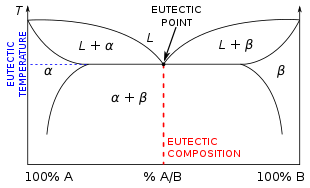
A eutectic system or eutectic mixture (/juːˈtɛktɪk/ yoo-TEK-tik)[1] is a type of a homogeneous mixture that has a melting point lower than those of the constituents.[2] The lowest possible melting point over all of the mixing ratios of the constituents is called the eutectic temperature. On a phase diagram, the eutectic temperature is seen as the eutectic point (see plot on the right).[3]
Non-eutectic mixture ratios have different melting temperatures for their different constituents, since one component's lattice will melt at a lower temperature than the other's. Conversely, as a non-eutectic mixture cools down, each of its components solidifies into a lattice at a different temperature, until the entire mass is solid. A non-eutectic mixture thus does not have a single melting/freezing point temperature at which it changes phase, but rather a temperature at which it changes between liquid and slush (known as the liquidus) and a lower temperature at which it changes between slush and solid (the solidus).
In the real world, eutectic properties can be used to advantage in such processes as eutectic bonding, where silicon chips are bonded to gold-plated substrates with ultrasound, and eutectic alloys prove valuable in such diverse applications as soldering, brazing, metal casting, electrical protection, fire sprinkler systems, and nontoxic mercury substitutes.
The term eutectic was coined in 1884 by British physicist and chemist Frederick Guthrie (1833–1886). The word originates from Greek εὐ- (eû) 'well' and τῆξῐς (têxis) 'melting'.[2] Before his studies, chemists assumed "that the alloy of minimum fusing point must have its constituents in some simple atomic proportions", which was indeed proven to be not the case.[4]
- ^ "eutectic". Merriam-Webster.com Dictionary. Merriam-Webster.
- ^ a b Guthrie, Frederick (June 1884). "LII. On eutexia". The London, Edinburgh, and Dublin Philosophical Magazine and Journal of Science. 5th series. 17 (108): 462–482. doi:10.1080/14786448408627543. p. 462:
The main argument of the present communication hinges upon the existence of compound bodies, whose chief characteristic is the lowness of their temperatures of fusion. This property of the bodies may be called Eutexia, the bodies possessing it eutectic bodies or eutectics (εὖ τήκειν).
- ^ Smith & Hashemi 2006, pp. 326–327
- ^ Britain), Chemical Society (Great (1885). Journal of the Chemical Society. Chemical Society.